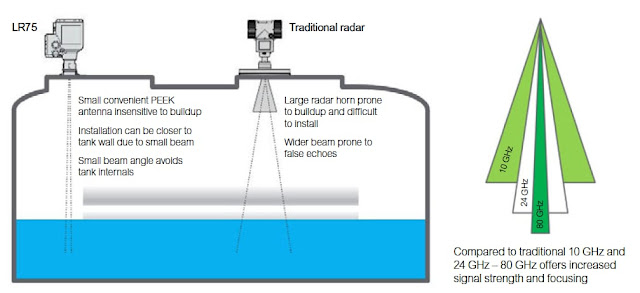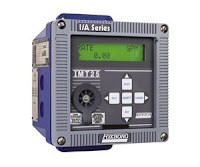Providing problem solving and educational information for topics related to industrial steam, hot water systems, industrial valves, valve automation, HVAC, and process automation. Have a question? Give us a call at (800) 892-2769 | www.meadobrien.com
Setting the Foxboro/Schneider Electric IDP10-A Differential Pressure Transmitter for Measuring Flow
Superior Process Measurement Performance for All Industries: EcoStruxure Process Instrumentation
Process instrumentation provides accurate, reliable measurement and analysis of pressure, flow, level, temperature, positioner, and process analytical variables so you have the process control you need for maximum integration and interoperability — all at competitive prices, low cost of ownership, and 24-hour worldwide support from a single source.
Schneider Electric’s process instrumentation is allied with various industry-leading brands that result in systems, software, and services that dramatically improve your operation’s economic, safety, and environmental performance. In addition, the deployment of multiple, advanced measurement systems will enhance the availability and utilization of all the assets on which your success depends.
Mead O'Brien
(800) 874-9655
https://meadobrien.com
Advantage Goes to Radar Level Over Ultrasonic Transmitters for Bulk, Dry Materials
Ultrasonic level transmitters used in dry bulk solids level monitoring are starting to be eclipsed. Radar level technology is now so good that it can get a level or distance signal from unreflective media such as polypropylene pellets. Compared to ultrasonics, radar is often more reliable, easier to use and has lower maintenance requirements.
The LR64 and LR65 from Schneider Electric (Foxboro) offer customers the benefit of reliable, trouble free solids level measurement. The radars use powerful Frequency Modulated Continuous Wave (FMCW) technology and advanced signal processing technology.
For more information, call Mead O'Brien now at (800) 892-2769 or visit their website at https://meadobrien.com.
Measuring Water and Liquid Level in Narrow, Obstructed Tanks with 80 GHz Non-Contact Radar Technology
The Foxboro Schneider Electric 80 GHz Radar (FMCW) Level Transmitter is ideal for measuring level of water and other liquids liquids in narrow tanks with internal obstructions.
The Schneider Electric (Foxboro) LR75 is a non-contact radar level transmitter that uses FMCW technology. It measures distance, level and volume of liquids and pastes. It has an empty spectrum function that filters false reflections caused by equipment inside the tank.- LR75 Free Space Radar
- 80 GHz FMCW technology
- cQPSus XP
- 4 -20mA /HART® 7
- 1/2" NPT Cable Entry
- Backlit Display
- (-14.5..580 psig) I (-40 deg F to +302 F) / FKM/FPM Process Seal
- 1-1/2“ DN40 Lens Antenna
- 1-1/2“ NPT ASME Process Connection
- Very low cost of ownership
Radar Level: The Relationship Between Frequency and Beam Angle and Using Beam Angle Calculators
The Schneider Electric Foxboro CFT51 Digital Coriolis Mass Flow and Density Transmitter with HART or Modbus Communication Protocol
The Schneider Foxboro Model CFT51 Digital Coriolis Mass Flow and Density transmitter is an advanced generation of mass flow devices using DSP (digital signal processing) technology, which allows this transmitter to provide improved performance over other Coriolis flowmeters. This mass flow and density meter, comprising a CFT51 mass flow and density transmitter and a Foxboro CFS mass flowtube, measures fluid mass flow rate directly, not inferentially. Direct measurement of mass helps eliminate the inaccuracies of multiple process measurements associated with volumetric flow devices.
For more information, contact Mead O'Brien. Call them at (800) 892-2769 or visit their web site at https://meadobrien.com.
Configuration and Setting the Schneider Electric / Foxboro IMT30A Magnetic Flow Signal Converter
The electromagnetic signal converter IMT30A is a used for measuring volumetric flow in various kinds of applications that can be found in the water industry and food and beverage processing. The IMT30A can be used together with Foxboro flow sensors 8400A, 8500A, 9500A, 9600A and 9700A with outputs representing measured values for flow, mass and conductivity.
Industries
- Water & Wastewater
- Food & Beverage
- Heating, Ventilation & Air Conditioning (HVAC)
- Agriculture
- Steel
- Water and wastewater treatment Water distribution network Irrigation installation
- Water abstraction
- CIP cleaning stations
(800) 892-2769
Basic Set up of the Schneider Electric / Foxboro LG01 Guided Wave Radar Level Transmitter
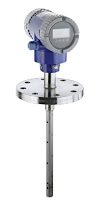 The Foxboro Model LG01 Radar level measurement transmitter provides very accurate and reliable level measurement for the widest choice of installation and application.
The Foxboro Model LG01 Radar level measurement transmitter provides very accurate and reliable level measurement for the widest choice of installation and application.Guided Wave Radar Technology
Process Instrumentation and Noise
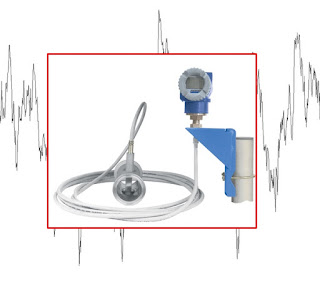 |
| Protect process instrumentation from electrical noise. |
Grounding allows for the reduction of noise stemming from electrical systems. Shielded cabling and separating signal cabling from other wiring, as well as replacing and repairing sensors, allows for noise reduction. Low-pass filters are a way to compensate for noise, and much of the instrumentation used in process systems incorporates noise dampening features automatically. Determining the best kind of filter to use depends heavily on cut-off frequency, alpha value, or time constant.
The ideal low-pass filter would eliminate all frequencies above the cutoff frequency while allowing every frequency below the cut-off frequency to be unaffected. However, this ideal filter is only achievable mathematically, while real applications must approximate the ideal filter. They calculate a finite impulse response, and also must delay the signal for a bit of time. To achieve better filter accuracy, a longer delay is needed so that the filter computation “sees” a bit further into the future. The calibration of these filters heavily relies on the desired accuracy level of the process, while also taking specific steps in calibration to best fit a particular process.
Noise is important to mitigate because the noise observed while measuring the process variable can produce “chatter” in the final control element of a process. The resulting “chatter” increases the wear of mechanical control elements, such as valves, and will generate additional cost for the process as a whole. The filtered signal lagging behind the dynamic response of the unfiltered signal is a result of the filtered signal’s increased dead time, meaning that signal filters add a delay in sensing the true process state. The solution is to find a mid-point between signal smoothing and information delay, which allows for elimination of noise while not negatively affecting the speed by which information is delivered.
Two Point Calibration of the Foxboro IDP-10-T Pressure Transmitter
Understanding Vortex Shedding Flow Technology
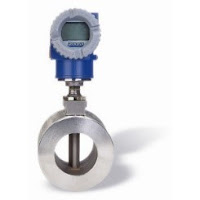 |
| Foxboro Vortex Shedding Flowmeter. Notice the shedder bar in the flow path. |
| Photograph of vortices (credit Jürgen Wagner via Wikipedia) |
Principles of Operation
A "shedder" bar (also known as a bluff body) in the path of
 |
| Animation of vortices (credit Cesareo de La Rosa Siqueira via Wikipedia) |
Typical Areas of Use
Vortex shedding flowmeters are used on steam, cryogenic liquids, hydrocarbons, air, feed water, and industrial gases.
Applications to Avoid
Splitting higher viscosity fluids into concordant vertices is extremely difficult due to the internal friction present, so using vortex shedding flowmeters on high viscosity media should be avoided. Also, avoid applications with low flow rates and low Reynolds Numbers, as the vortices created are unstable.
Consideration for Use
Consideration must be given to applications with low Reynolds numbers, as the generation of vortices declines at critical points of reduced velocity. Low pressure can also be a problem in this regard. Users must take Reynolds number, velocity, and density into consideration before choosing a vortex shedding flow meter. As always, it's best to discuss your application with an knowledgable support professional before specifying, purchasing, or installing this type of flowmeter.
Watch the video below for more information on vortex flow technology.
For more information on vortex shedding flowmeters, visit https://www.meadobrien.com or call (800) 892-2769.
Foxboro IMT25 Flow Transmitter Quick Start Video and IOM - Everything You Need
- Digital precision, stability, and resolution ensure top measurement performance.
- Remote communication with HART communication protocol. (For FOUNDATION Fieldbus protocol, refer to PSS 1-6F5 B.)
- Remote configuration using PC-based configurator or HART Communicator.
- Local configuration using optional integral keypad, with backlighted, 2-line, LCD display.
- Scaled pulse or frequency output.
- Unidirectional or bidirectional flow.
- Analog output programmable for unidirectional, bidirectional, or multiple input range.
- Relay outputs with programmable functionality for alarms.
- Contact inputs with programmable functionality for remote operation.
- Automatic and manual zero lock.
- Online diagnostic help.
- Software configuration and totals protected in nonvolatile memory in the event of power loss.
- Compact single or dual compartment.
- Enclosure meets NEMA 4X and IEC IP66.
- Field test mode using Foxboro Model IMTSIM Magnetic Flowtube Simulator.
HART Communication Protocol - Process Instrumentation
 |
| Process instrument with HART protocol (Foxboro) |
HART instruments have the capacity to perform in two main modes of operation: point to point, also known as analog/digital mode, and multi-drop mode. The point to point mode joins digital signals with the aforementioned 4-20 mA current loop in order to serve as signal protocols between the controller and a specific measuring instrument. The polling address of the instrument in question is designated with the number "0". A signal specified by the user is designated as the 4-20 mA signal, and then other signals are overlaid on the 4-20 mA signal. A common example is an indication of pressure being sent as a 4-20 mA signal to represent a range of pressures; temperature, another common process control variable, can also be sent digitally using the same wires. In point to point, HART’s digital instrumentation functions as a sort of digital current loop interface, allowing for use over moderate distances.
HART in multi-drop mode differs from point to point. In multi-drop mode, the analog loop current is given a fixed designation of 4 mA and multiple instruments can participate in a single signal loop. Each one of the instruments participating in the signal loop need to have their own unique address.
Since the HART protocol is a standardized process control industry technology, each specific manufacturer using HART is assigned a unique identification number. This allows for devices participating in the HART protocol to be easily identified upon first interaction with the protocol. Thanks to the open protocol nature, HART has experienced successive revisions in order to enhance the performance and capabilities of the system relating to process control. The standardization of “smart” implementation, along with the ability to function with the legacy 4-20 mA technology and consistent development, has made HART a useful and popular component of the process measurement and control industry framework.
Have a question about HART? Contact Mead O'Brien by visiting this link, or call
(800) 892-2769.
Common Ways to Measure Steam Flow
When compared to other liquid flow measuring, the measuring of steam flow presents one of the most challenging measuring scenarios. Most steam flowmeters measure a velocity or volumetric flow of the steam and, unless this is done carefully, the physical properties of steam will impair the ability to measure and define a mass flow rate accurately.
Steam is a compressible fluid; therefore, a reduction in pressure results in a reduction in density. Temperature and pressure in steam lines are dynamic. Changes in the system’s dynamics, control system operation and instrument calibration can result in considerable differences between actual pressure/temperature and a meter’s design parameters. Accurate steam flow measurement generally requires the measurement of the fluid’s temperature, pressure, and flow. This information is transmitted to an electronic device or flow computer (either internal or external to the flow meter electronics) and the flow rate is corrected (or compensated) based on actual fluid conditions.
The temperatures associated with steam flow measurement are often quite high. These temperatures can affect the accuracy and longevity of measuring electronics. Some measuring technologies use close-tolerance moving parts that can be affected by moisture or impurities in the steam. Improperly designed or installed components can result in steam system leakage and impact plant safety. The erosive nature of poor-quality steam can damage steam flow sensing elements and lead to inaccuracies and/or device failure.
The challenges of measuring steam can be simplified measuring the condensed steam, or condensate. The measuring of condensate (i.e., high-temperature hot water) is an accepted practice, often less expensive and more reliable than steam measuring. Depending on the application, inherent inaccuracies in condensate measuring stem from unaccounted for system steam losses. These losses are often difficult to find and quantify and thus affect condensate measurement accuracy.
Volumetric measuring approaches used in steam measuring can be broken down into two operating designs:
- Differential pressure
- Velocity measuring technologies.
DIFFERENTIAL
For steam three differential pressure flowmeters are highlighted: orifice flow meter, annubar flow meter, and spring-loaded variable area flow meter. All differential pressure flowmeters rely on the velocity-pressure relationship of flowing fluids for operation.
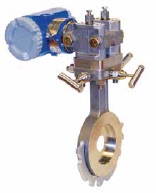 |
| Orifice Flow Meter (courtesy of Foxboro) |
Differential Pressure – Orifice Flow Meter
Historically, the orifice flow meter is one of the most commonly used flowmeters to measure steam flow. The orifice flow meter for steam functions identically to that for natural gas flow. For steam measuring, orifice flow flowmeters are commonly used to monitor boiler steam production, amounts of steam delivered to a process or tenant, or in mass balance activities for efficiency calculation or trending.
Differential Pressure – Annubar Flow Meter
The annubar flow meter (a variation of the simple pitot tube) also takes advantage of the velocity-pressure relationship of flowing fluids. The device causing the change in pressure is a pipe inserted into the steam flow.
Differential Pressure – Spring-Loaded Variable Area Flow Meter
The spring-loaded variable area flow meter is a variation of the rotameter. There are alternative configurations but in general, the flow acts against a spring-mounted float or plug. The float can be shaped to give a linear relationship between differential pressure and flow rate. Another variation of the spring-loaded variable area flow meter is the direct in-line variable area flow meter, which uses a strain gage sensor on the spring rather than using a differential pressure sensor.
VELOCITY
The two main type of velocity flowmeters for steam flow, turbine and vortex shedding, both sense some flow characteristic directly proportional to the fluid’s velocity.
Velocity – Turbine Flow Meter
A multi-blade impellor-like device is located in, and horizontal to, the fluid stream in a turbine flow meter. As the fluid passes through the turbine blades, the impellor rotates at a speed related to the fluid’s velocity. Blade speed can be sensed by a number of techniques including magnetic pick-up, mechanical gears, and photocell. The pulses generated as a result of blade rotation are directly proportional to fluid velocity, and hence flow rate.
 |
| Vortex Flowmeter (courtesy of Foxboro) |
Velocity – Vortex-Shedding Flow Meter
A vortex-shedding flow meter senses flow disturbances around a stationary body (called a bluff body) positioned in the middle of the fluid stream. As fluid flows around the bluff body, eddies or vortices are created downstream; the frequencies of these vortices are directly proportional to the fluid velocity.
For more information on process steam management, contact Mead O'Brien by visiting http://www.meadobrien.com or call (800) 892-2769,
What are Magnetic Flowmeters and How Do They Work?
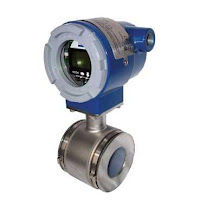 |
| Magnetic Flowmeter (courtesy of Foxboro Schneider Electric) |
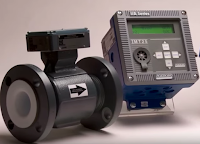 |
| Magnetic Flowmeter and controller. (courtesy of Foxboro Schneider Electric) |
A Magmeter Designed to Withstand the Most Common Failure Modes
 |
| Foxboro magnetic flowmeter and transmitter. |
Foxboro magnetic flowmeters, however, solve these industry-wide issues with superior construction, compact design, the widest selection of options, combined with low power consumption.
Foxboro magnetic flow tubes utilize a superior electrode. By using large electrodes, the flowmeter output is less sensitive to the effects of entrained air, and unaffected by higher internal pressures.
Rugged Teflon liners are resistant to chemical attack which makes it possible to use the Foxboro magnetic flowmeter in hard to handle corrosive liquids and slurries.
Finally, Foxboro magnetic flowmeters offer system accuracy of plus or minus 0.25 percent of reading.
Foxboro flow tubes can be paired with there IMT 25 and IMT 96 transmitter for complete compact system that provides unequalled durability measurement accuracy and performance with virtually no maintenance and minimal replacement cost covering the widest choice of industry applications available.
For more information on Foxboro magnetic flowmeters please contact Mead O'Brien at (800) 892-2769 or visit http://www.meadobrien.com.
Enhancing Cyber Security in Industrial Control Systems and Critical Infrastructure with Dynamic Endpoint Modeling
Cyber attacks against Industrial Control Systems (ICS) are on the rise, putting nations’ critical infrastructure at risk. In a paradigm shift from the traditional network security systems, a new approach — Dynamic Endpoint Modeling — learns and models the behavior of all devices on the network and triggers alerts when algorithms detect changes in learned behavior.
Read the entire white paper below.
Foxboro Vortex Flow Meters
 The patented family of Foxboro vortex flowmeters has the high accuracy and rangeability of positive displacement and turbine flowmeters without the mechanical complexity and high cost. Maximum rangeability up to 100:1 is possible as compared to 3:1 for a nonlinear differential pressure producer (orifice plate).
The patented family of Foxboro vortex flowmeters has the high accuracy and rangeability of positive displacement and turbine flowmeters without the mechanical complexity and high cost. Maximum rangeability up to 100:1 is possible as compared to 3:1 for a nonlinear differential pressure producer (orifice plate).Because these Flowmeters have no moving parts, they are very durable and reliable. This simplicity of design ensures low initial cost, low operating and maintenance costs, and therefore contributing to an overall low cost of ownership.
A Guide to Instrumentation for Ethanol Fuel Production
 |
| Ethanol plant |
The two main processes to produce ethanol from corn are wet milling and dry milling.
 |
| Foxboro transmitter |
Wet milling is more versatile as it produces a greater variety of products, including starch, corn syrup, and sucralose (such as Splenda®). However, with this versatility come higher costs in mill design, building, and operation. If ethanol is the primary product produced, dry mills offer the advantages of lower construction and operations costs, with improved production efficiency. Of the more than 70 U.S. ethanol plants currently being built, only a few are wet mills.
The efficiency of ethanol production has come a long way during the last 20 years. As more large-scale facilities come on line, ethanol producers are faced with the growing challenge of finding innovative ways to maintain profitability while this market matures. An increasingly accepted solution is process automation to assist ethanol producers in controlling product quality, output, and costs. Because sensing and analytical instrumentation represents what is essentially the eyes and ears of any automation system, careful evaluation of instrumentation, at the design phase can reduce both equipment and operating costs significantly, while improving overall manufacturing effectiveness.
The following document, courtesy of Foxboro, provides a good overview of instrumentation and the production of ethanol.
A Better Alternative to Magmeter for Unpolished Condensate Flow Measurement
 |
| Veris Accelabar |
A magnetic flowmeter uses an electric current applied to a coil which produces a magnetic field. When conductive liquid flows through the magnetic field, a small voltage, proportional to the liquid velocity, is induced. As long as the interior surfaces of the Magmeter are clean and unobstructed, the meter accurately measures flow. If they get dirty or coated, all bets are off.
It was in the above mentioned upset situations where the University maintenance people were having problems. When upsets occurred, and the condensate polisher had to be by-passed, it meant the Magmeter would also have to be serviced because accuracy could no longer be guaranteed. Servicing the Magmeter was slow and costly. It meant shutting down the line, draining the pipe, removing the flowmeter, cleaning, and then putting it all back together.
Armstrong International’s Veris Group was called in for a consult. After review, the Veris Group recommended installing an Accelabar® flow meter to offer an alternative solution that could provide reliable flow measurement regardless of an upset condition like unpolished condensate. The Accelabar provided a flow range of 22.5:1 turndown in flow, in a limited straight run scenario. In the past, two transmitters were required to provide the best accuracy across the entire range of the Accelabar. Veris was able to use the Foxboro IDP 10S with its FoxCal™ technology in order to have a combined percent of rate accuracy solution.
The new transmitter installation has 11 separate calibrations loaded into the device. As the differential pressure from the primary element is measured, the transmitter chooses the correct calibration curve. Veris’ solution delivered performance that was previously unattainable with a single differential pressure transmitter.
The Accelabar and Foxboro combined to be best solution, and the Accelabar flow meter is now the University's standard for the boiler feed water measurements.
For more information, contact:
Mead O'Brien, Inc.
10800 Midwest Industrial Blvd
St Louis, MO 63132
314-423-5161
314-423-5707
www.meadobrien.com

